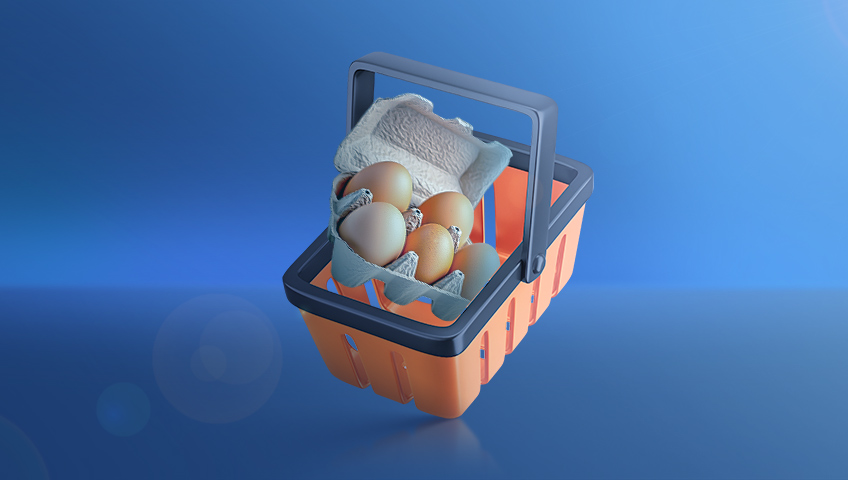2025.12.09
Eggs are recognized as a highly valuable food source and hold significant importance in human diets. Eggs are an excellent and cost-effective source of high-quality proteins and beneficial fats, which help meet the body’s energy needs. In addition, eggs can provide micronutrients, such as vitamins and minerals essential for the body’s health.
Since ancient times, eggs have held a special place in Iranian cuisine, and today, depending on the food culture of each region, there are various methods for preparing them. Eggs are used not only in main dishes but also in the preparation of desserts and beverages due to their unique characteristics, such as their ability to create fluffiness in cakes and their effective role in improving the composition of food. They have become a key component in cooking.
These factors have increased the popularity of eggs among people, ultimately leading to a rise in per capita egg consumption.
Per Capita Egg Consumption
According to statistics released by the Food and Agriculture Organization (FAO) in 2023, the global per capita egg consumption in 2021 was 10.4 kilograms per person, while in Iran, it was nearly 9 kilograms (8.87 kilograms).

Reasons for Eggs’ Susceptibility to Contamination and Spoilage, Especially Outside the Refrigerator
Eggs are susceptible to spoilage due to their structure and specific composition. Their thin and porous shell easily allows air and microbes to enter. Additionally, the egg white and yolk, because of their high water and protein content, create an ideal environment for bacteria to grow.
If eggs are stored at room temperature, the growth rate of bacteria, especially Salmonella, increases significantly. Furthermore, the room temperature causes water in the egg white to evaporate more quickly, which thickens the egg white. The yolk, due to its fat content and insoluble proteins, has less water than the white and doesn’t lose water through evaporation as much. However, the thickening of the white affects the yolk as well. Ultimately, the thickening of both the yolk and white leads to a reduction in egg quality, meaning a decrease in nutritional value and a reduction in freshness.
Additionally, as water evaporates, the pores of the shell open more, allowing air to replace the water, making it easier for microbes to enter, which can accelerate spoilage.
Therefore, to maintain the quality of eggs and prevent spoilage, it is essential to store them under proper conditions, particularly in the refrigerator at around 4°C. Furthermore, paying attention to important considerations when purchasing eggs is vital to ensure their health and quality.
Important Considerations for Ensuring Egg Health When Purchasing
- Storage Conditions in the Store
It is essential to ensure that eggs are stored in hygienic and cool conditions (inside a refrigerator) in the store, as proper temperature maintenance helps preserve freshness and prevents bacterial growth.
- Shell Condition
Eggs should have clean shells free of cracks. Broken or cracked eggs can increase the risk of bacteria entering the egg's contents, so these eggs should be avoided. Additionally, eggs with external contamination, such as poultry droppings, should also be avoided, as these contaminants can serve as a source of harmful bacteria. The color of the shell (white or brown) has no bearing on the health or quality of the egg and is primarily related to the breed of the hen. Therefore, the shell color should not be used as an indicator of the egg's health or quality.
- Health Labels and Expiration Date
It is important to pay attention to the labels on the egg carton. These labels should include the manufacturer's details, production and expiration dates, and any relevant health certifications, such as a standard certification or approvals from the Food and Drug Administration. Checking the production and expiration dates is very important. If the date is not printed on locally sourced eggs, it is necessary to ask the seller for the production date.
Important Considerations for Evaluating Egg Quality When Purchasing
On the egg carton, in addition to the production and expiration dates and health labels, other details such as the egg grade, size, and more are provided. These pieces of information indicate the quality of the eggs. Some of these are outlined below:
- Egg Grade
Eggs are classified into different grades based on their internal and external quality. The two main criteria in this classification are the shell quality and internal quality (egg white and yolk). The higher the quality of the shell and internal structure of the egg, the better its grade.
- AA: These are the highest-quality eggs with a flawless shell, very thick egg white, and a round yolk. This grade is used for very high-quality eggs in some countries.
- A: Grade A eggs have clean, smooth, and intact shells. The yolk is centered and round, and the egg white is thick and clear.
- B: Grade B eggs may have minor defects in the shell, such as roughness or small spots, and their egg white may be a bit watery. This grade still represents a healthy egg, but with a lower quality than grade A.
- Egg Size
Eggs are also categorized by size (small, medium, large). The size of an egg is more related to its weight and does not significantly affect its nutritional value or internal quality.
- Other Quality Certifications
Some eggs may have specific quality certifications, such as being organic or other approved certifications. These certifications indicate that the hens' health and nutritional standards have been met, and generally, these eggs are considered to be of higher quality.
- Egg Freshness
Fresh eggs undoubtedly have better quality. You can determine the freshness or age of an egg at home using simple tests. Here are some tests to check:
- Smell the egg, If you detect an unpleasant odor, it might be a sign of spoilage.
- Shake the egg near your ear, If you hear a sound, it could indicate the egg is old.
- Fill a container with water and submerge the egg. If the egg lies flat at the bottom of the container, it is fresh. If it stands upright on the bottom, it is old, and if it floats to the surface, it is spoiled.
- Crack the egg onto a flat surface and observe, If the yolk is round and sits on top of a thick or gel-like egg white, it is fresh. If the egg white is thin and runny and easily mixes with the yolk, the egg is old or spoiled.
In general, when buying healthy and high-quality eggs, choosing reputable stores and sellers plays an important role in ensuring the health and quality of the product. Reputable sellers typically offer eggs that meet hygiene and quality standards. Additionally, the price of eggs can serve as an indicator of their quality. Extremely cheap eggs are usually of lower quality. Therefore, it is recommended to consider the price and the reputation of the seller and to purchase from trusted stores.


